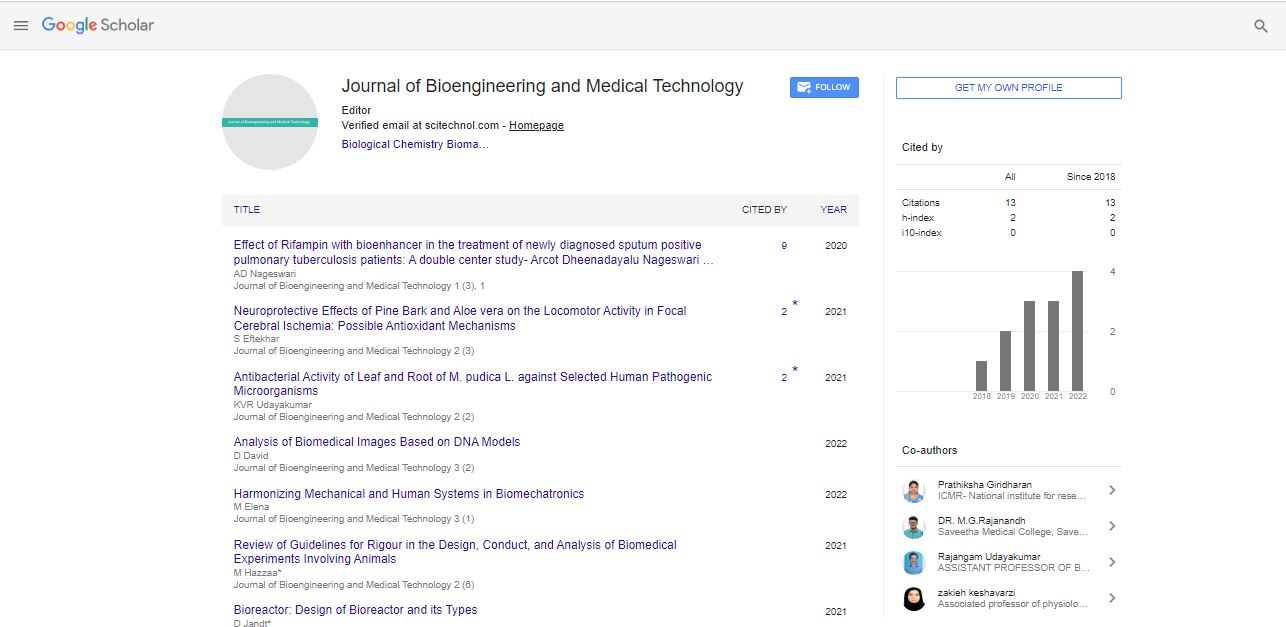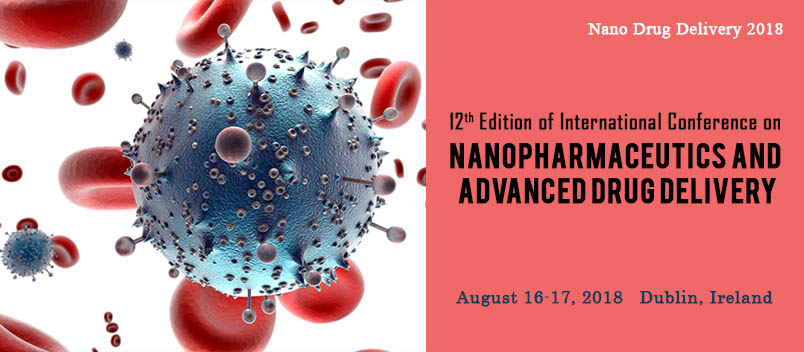Perspective, J Bioeng Med Technol Vol: 3 Issue: 2
Complex Oxide Thin Films: New Nanoscale Engineering Possibilities
Roberto Spoladore*
Department of Medical Laboratory Diagnostics-Fahrenheit Biobank, Medical University of Gdansk, Gdansk, Poland
*Corresponding Author:Roberto Spoladore
Department of Medical Laboratory Diagnostics-Fahrenheit Biobank, Medical University of Gdansk, Gdansk, Poland
Email: robertospoladore@gmail.com
Received date: 25 February, 2022; Manuscript No. JBMT-22-59948;
Editor assigned date: 28 February, 2022; PreQC No. JBMT-22-59948(PQ);
Reviewed date: 14 March, 2022; QC No JBMT-22-59948;
Revised date: 21 March, 2022; Manuscript No. JBMT-22-59948(R);
Published date: 28 March, 2022; DOI: 10.4172/jbmt.100056.
Citation: Spoladore R (2022) Complex Oxide Thin Films: New Nanoscale Engineering Possibilities. J Bioeng Med Technol 3:2.
Keywords: Nanoscale Engineering
Introduction
Complex oxides are becoming more and more prevalent in current technology. Understanding how these materials grow and behave is critical for the development of new devices and the improvement of current ones. Controlling the formation of thin layer oxides is critical for fine-tuning the properties that are required for device optimization. Some recent advancement in nanoscale engineering of functional oxides is reviewed in this article. Controlling film structure through growth kinetics manipulation and substrate issues are presented. The use of composites and artificial materials in construction is also taken into account. A future outlook is also addressed, as well as a path to industrial scale implementation. Many technologies futures have become reliant on complicated oxides in recent years. Magnetism, ferro electricity, and superconductivity, to mention a few, are examples of physical features that complex oxides can display. Small changes in temperature, strain, pressure, or elemental ratio can influence the phase diagram of these compounds and solid solutions, causing a change in property. Understanding and developing new methods of engineering these events is so critical.
It is feasible to design and optimize highperformance materials for use in existing and emerging technologies by doing so. Furthermore, the ability to process these new materials into architectures appropriate for inclusion into devices, such as thin films, is critical. On sizes ranging from the microstructural to the unit cell level, there are numerous ways to design the structure of thin film oxides. Small alterations in deposition circumstances can have a significant impact on growth kinetics, resulting in significant changes in crystalline quality, microstructure, and defect concentration; these phenomena can have a significant impact on the film's physical attributes. The structural phase can also be adjusted by changing the oxygen content. Strain can be incorporated into a film by carefully selecting the substrate or controlling the development kinetics, allowing for considerable changes in physical properties. In ferroelectrics, a strain of less than 1% can cause a Curie temperature change of hundreds of degrees. When two or more of these complicated oxides with distinct properties are combined in a composite structure, the properties can be coupled, resulting in a magneto electric material with connected ferroelectric and magnetic ordering. These phenomena can be regulated to improve the performance of materials for a certain device output.
Techniques to Grow Thin Films
Many approaches are used to generate thin films, however the growth of materials with various cationic species is complicated, thus certain techniques are better than others. Chemical Vapour Deposition (CVD) techniques like Atomic Layer Deposition (ALD) may generate films with extremely high crystallographic quality and are easily adaptable to large-scale commercial processes. However, CVD development of complex oxides is difficult and frequently results in structural disorder and off-stoichiometric growth. PVD techniques are particularly suited to the formation of these materials because they allow for stoichiometric deposition and the easy creation of artificial materials by layering two or more chemicals together. Molecular Beam Epitaxy (MBE) has long been thought to provide high-quality epitaxial growth, but other PVD techniques, like as Pulsed Laser Deposition (PLD), are increasingly creating films of comparable or greater quality.
However, it produces poor deposition rates and has a limited parameter space for effective growth. Low deposition pressures might result in oxygen-deficient films, which is undesirable. These characteristics of MBE limit structural engineering by kinetic manipulation of films, and so are beyond the purview of this review. PLD, on the other hand, works far from equilibrium, resulting in a large parameter space with a wide range of deposition rates, all of which lead to stoichiometric growth. These characteristics enable structural engineering through the manipulation of growth kinetics, and they will be the subject of this review. The use of this approach in conjunction with in situ differentially pumped Reflection High-Energy Electron Diffraction (RHEED) has resulted in a better understanding of growth mechanisms as well as in situ monitoring of layer creation and crystallography. These advancements have resulted in film quality that is on par with, if not better than, more classic techniques like MBE. Furthermore, there have been examples of industrial-scale PLD in recent years, demonstrating the technique's evolution from a solely research tool to a viable route to mass-production of innovative devices. Physical Vapour Deposition (PLD) is a typical method of deposition. In the presence of an oxygen partial pressure, a highpowered UV pulsed laser is focused onto a ceramic stoichiometric target. To reach the optical absorption depth, the target is heated, evaporated, and ionized.
Electron Microscopy
Adatoms deposited in one pulse must locate stable locations within the interval between pulses due to surface mobility and deposition rate. In PLD, the kinetics of growth is far from equilibrium. The importance of surface super saturation cannot be overstated. In the nucleation stage of each monolayer, higher super saturation results in a higher density of smaller islands developing. Smaller two-dimensional islands minimize the distance an adatom must travel to reach a stable site at the island edge, which lowers the likelihood of second layer nucleation. It is feasible to determine the development mode and, as a result, the microstructure of a film by knowing and managing these aspects of PLD. Due to its grazing incidence, RHEED is a twodimensional diffraction technique, with electrons only reaching the top atomic layers of the surface. The limited penetration depth causes an array of reciprocal lattice rods to protrude from the surface. The reciprocal lattice rods broaden as a result of surface disorder caused by crystallographic flaws and surface roughening. As a result, the intersection with the Ewald sphere broadens, resulting in streaking of the diffraction peaks on the RHEED screen. A three-dimensional array of lattice points appears when roughness reaches the point of transmission through surface features. As a result, the seen pattern transforms into a grid-like structure, similar to that seen in Transmission Electron Microscopy (TEM). These qualities enable insitu monitoring of the increasing structure and interface roughness, both of which are critical in the development of super lattices and artificial layered materials.
Any diffraction spot's real-time intensity variations provide information on growth mode and rate. Steps on the surface scatter electrons out of the beam. The step density increases as a layer grows, resulting in a drop in RHEED intensity. There is a maximum stepdensity (depending on island shape) and a minimum intensity at about half coverage. As the layer grows, the step density falls, and the layer is finished, resulting in an intensity maximum. One RHEED oscillation corresponds to the deposition of one stoichiometric unit of material with this oscillatory characteristic. In some circumstances, two-dimensional growth optimization in traditional PLD is prevented by interface mismatch or temperature instability. In such cases, it is feasible to modify the growth kinetics in the PLD process to improve the growth quality. Interval deposition is one such modification that takes use of PLD's operating far from equilibrium to force layer-bylayer development. The laser is fired at a high frequency for exactly the number of pulses needed to deposit one monolayer. Deposition of the layer happens in under the relaxation period under these conditions, resulting in an exceptionally high super saturation on the surface. During the nucleation process, a dense layer of small twodimensional islands grows on the surface. Until the laser is turned on, there is a dramatic drop in intensity, which remains low as the layer is deposited.
A large density of mobile adatoms on the surface scatters electrons out of the beam, causing this steep dip. When the deposition phase is finished, the laser is turned off, and the adatoms begin to relax into stable locations. Once the deposition pulse is ended, RHEED intensity returns in an exponential way to a steady state. The present monolayer is entirely crystallized and the surface is atomically smooth at this point. If the deposition conditions are optimized, this process can be repeated endlessly to create a high-quality film of any thickness. After each monolayer is placed, there is usually a modest decline in RHEED intensity. This is due to the fact that only an integer number of pulses may be deposited at a time, resulting in an inaccuracy in the amount of material deposited per monolayer. As a result, a balance must be struck between the need for a large number of pulses per monolayer to reduce inaccuracy and the requirement for monolayer deposition to be finished in less than the relaxation time.
 Spanish
Spanish  Chinese
Chinese  Russian
Russian  German
German  French
French  Japanese
Japanese  Portuguese
Portuguese  Hindi
Hindi 
